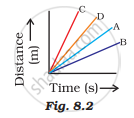Advertisements
Advertisements
Question
Exercise Problems.
An athlete completes one round of a circular track of diameter 200 m in 40 s. What will be the distance covered and the displacement at the end of 2 m and 20 s?
Solution
Given: Diameter of circular track = 200m
time to complete = 40s
Formula: Circumference of circular track = d. π m
speed = `"distance"/"time"`
Solution:
Circumference of the track = d.π
= 200 × 3.14 = 628m
speed = `"628m"/"40s"` = 15.7 ms– 1
Distance covered in 2 min 20 s = speed × time
In the given time athlete covers 31/2 rounds = 2198m

The final position of athlete is as shown in figure (A – initial position, B – final position)
∴ Displacement = Distance × time
= 200 m
APPEARS IN
RELATED QUESTIONS
Fill in the following blank with suitable word :
Displacement is a…………………… quantity whereas distance is a………………………….
Can displacement be zero even if the distance is not zero? Give one example to explain your answer.
Can displacement-time sketch be parallel to the displacement axis? Give a reason to your answer.
Draw a velocity-time graph for a body moving with an initial velocity u and uniform acceleration a. Use this graph to find the distance travelled by the body in time t.
Give two differences between displacement and distance.
A car travels at a uniform speed of 42 km/h. In 10 minutes, how much distance would it cover?
The table below shows the distance travelled by two vehicles A and B during each second:
| Time (s) | 0 | 1 | 2 | 3 | 4 | 5 | 6 | 7 |
| Distance travelled by A (m) | 0 | 20 | 80 | 180 | 240 | 300 | 360 | 420 |
| Distance travelled by B (m) | 0 | 10 | 40 | 90 | 160 | 250 | 360 | 490 |
Which vehicle is moving with a constant acceleration?
Which of the following figures represent uniform motion of a moving object correctly?
Four cars A, B, C, and D are moving on a levelled road. Their distance versus time graphs are shown in Fig. 8.2. Choose the correct statement.

In which of the following cases of motions, the distance moved and the magnitude of displacement are equal?
